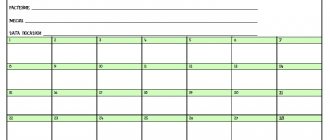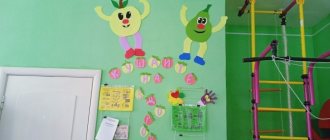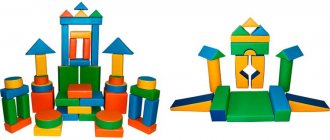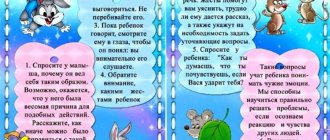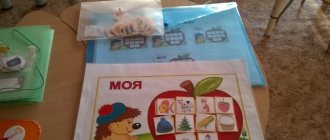The relevance of building a subject-development environment in preschool educational institutions in accordance with the State Standards
The relevance of constructing a subject-developmental
environment in the preschool educational institution in accordance with the State Standards
Andreeva T.V.,
senior teacher of preschool educational institution No. 166
The issue of organizing a subject-developmental environment in preschool educational institutions is particularly relevant today. In connection with the introduction of the State educational standard for preschool education for 2015-2017. requirements were developed for the conditions for the implementation of the Model Program, including requirements for the subject-development environment (p. III, clause 3.3). Why are such high demands placed on the development environment of preschool educational institutions? The answer to this question is connected, first of all, with the specifics of preschool age, with those features in which a preschooler differs from older subjects of education. The source of knowledge, social experience and development of a preschool child is his environment. Therefore, it is very important that this environment is developmental. All children, as we know, are different, and each preschooler has the right to his own path of development, therefore, in order to realize the individual interests, inclinations and needs of preschoolers, the subject-development environment must provide each child with the right and freedom to choose an activity.
Targets for completing preschool education are clearly outlined in the Model Program “From Birth to School”. The child must have initiative and independence in various types of activities, the ability to choose occupations and partners, the ability to generate and implement various ideas, self-confidence and openness to the outside world. Therefore, a developing subject-spatial environment that stimulates the child’s communicative, playful, cognitive, physical and other types of activity must be organized in accordance with the age-specific specifics of his development.
Organization of a developing subject-spatial environment in a preschool educational institution with
taking into account the State Educational Standard is structured in such a way as to enable the most
effectively develop the individuality of each child, his inclinations,
interests, level of activity.
The developing subject-spatial environment is organized so that
every child had the opportunity to freely do what they loved.
Rich developmental subject - spatial and educational
the environment becomes the basis for organizing an exciting, meaningful
life and diversified development of every child. The developing subject environment is the main means of personality formation
child and is the source of his knowledge and social experience.
I would like to draw your attention to the fact that research into the subject environment has been going on for a long time. The environment as a multicomponent phenomenon is a subject of study by philosophers, educators, philosophers, ecologists, psychologists, and other specialists. From the standpoint of the psychological context, according to L. S. Vygodsky, P. Ya. Galperin, V. V. Davydov, L. V. Zankov, A. N. Leontyev, D. B. Elkonin and others, the developmental environment is a certain ordered educational space in which developmental learning is carried out.
The famous French teacher Celestin Frenet believed that thanks to the environment, the child himself can develop his individual abilities and capabilities. The role of an adult is to correctly model an environment that promotes maximum development of the child’s personality.
The very concept of a subject-based developmental environment was introduced into the lexicon of teachers and designers after 1988, when the Concept of Preschool Education was published; research in this area began much earlier. With the release of a standard project for the construction of kindergartens (1932), the question of group equipment and the organization of children’s living space (“corners”, “zones”) was raised. The scientific development of object-based play equipment began with the opening of the Research Institute of Preschool Education (1960). S. L. Novoselova and N. N. made a great contribution to the creation of a system of educational toys and teaching aids. Poddyakov (1968). By the mid-70s, principles for the formation of a subject environment were developed: a new pedagogical classification of toys was proposed, educational modular game environments, construction sets, and a system of educational toys for young children were developed (G.G. Lokutsievskaya, N.N. Poddyakov, L.A. Paramonova, S.L. Novoselova, N.T. Grinyavichina, E. V. Zvorygina, etc.). In the second half of the 80s, the concept and operating system of “computer gaming complex” (CGC) was developed, under the scientific leadership of N.N. Poddyakova, S.L. Novoselova, L.A. Paramonova. In the 90s, the question of enriching the subject-development environment was raised in the works of V.A. Petrovsky,
Most experts use the concept of Doctor of Psychological Sciences S.L. Novoselova: “A developing subject environment is a system of material objects of a child’s activity that functionally modernizes the content of the development of his spiritual and physical appearance. An enriched developmental environment presupposes the unity of social and natural means of ensuring a child’s varied activities.”
All children, as we know, are different, and each preschooler has the right to his own path of development, therefore, in order to realize the individual interests, inclinations and needs of preschoolers, the subject-development environment must provide each child with the right and freedom to choose an activity. However, the environment in groups often does not correspond to the interests of children and does not encourage them to make independent free choices. The psychological foundations for constructing a developmental, subject-based childhood environment are based on the activity-age system approach and modern ideas about the subject-oriented nature of activity, its development and significance for the mental and personal development of the child. The works of many domestic teachers (G.M. Lyamin, A.P. Usov, E.A. Panko) talk about the need to include preschoolers in meaningful activities, during which they themselves could discover more and more new properties of objects, notice them similarities and differences. In a word, it is necessary to provide children with the opportunity to acquire knowledge on their own.
S.L. Novoselova argues that activity in its development constantly changes its psychological content depending on the subject’s generalization of his experience. Activity builds the psyche. Inactivity, the lack of opportunity to do something, leads to limited opportunities, and subsequently to personality deprivation. The objective world of childhood is the environment for the development of all specific types of activity.
The subject development environment is:
- a system of material objects and means of activity of a child, functionally modeling the content of the development of his spiritual and physical appearance in accordance with the requirements of the basic general educational program of preschool education.
- this is a complex of aesthetic, psychological and pedagogical conditions necessary for the implementation of the pedagogical process, rationally organized in space and time, saturated with a variety of objects and gaming materials.
The environment surrounding children in kindergarten should ensure the safety of their lives, promote health and strengthen the body of each of them. The principle of integration of educational areas contributes to the formation of a unified subject-spatial environment.
This means that for the comprehensive development of the child,
several subject developmental “environments”: for speech, mathematics,
aesthetic, physical development, which, depending on the situation
can be combined into one or more multifunctional environments. At
In this regard, it is very important that the objects and toys that will be used
child, at the first stage of mastering this environment were not just objects
his attention, but a means of communication with adults.
Organization of a developing subject-spatial environment during the implementation of project activities
Arzamaskova Anastasia Vladimirovna
Organization of a developing subject-spatial environment during the implementation of project activities
Speech at the RMO
«Organization of a developing subject-spatial environment during the implementation of project activities»
Kurgan region “Lesnikovsky kindergarten No. 2” teacher: Arzamaskova A. V. 2022
Listen and you will forget, watch and you will remember,
do it and you will understand.
Confucius
Working on my topic for several years, I noticed that children, spending most of their time in kindergarten, develop in the process of upbringing and learning, that is, in active, meaningful activities with adults and peers. environment must be created around the child in which he develops sensory skills, accumulates life experience, learns to organize and compare different objects and phenomena , gains experience in emotional and practical interaction with adults and peers, and acquires knowledge from his own experience.
When starting to study this problem, I asked myself the question: “What is the novelty of the topic, its relevance?”
And the fact is that when creating a competently
organized developmental subject-spatial environment , children develop self-confidence , independence, initiative, and creativity are manifested.
I also set myself the following goals and objectives:
Goal: to develop a model of a developing subject-spatial environment that promotes the harmonious development and self-development of children with its subsequent formation and bringing it into compliance with the requirements of the Federal State Educational Standard of Preschool Education.
Tasks:
— To study and put into practice new approaches to organizing a subject-spatial developmental environment that ensures the full development of preschool children within the framework of the educational program of a preschool educational institution, taking into account the requirements of the Federal State Educational Standard for Preschool Education, namely:
— organize a subject-spatial developmental environment that promotes the emotional well-being of children, taking into account their needs and interests;
— create conditions for providing different types of activities for preschoolers ;
— to promote cooperation between children and adults to create a comfortable subject-spatial development environment ;
— to introduce preschoolers to active subject-transformative activities in the interior .
According to the requirements of the Federal State Educational Standard, a developing subject-spatial environment must :
provide the opportunity for communication and joint activities between children and adults .
ensure the implementation of various educational programs.
should be: content-rich, transformable, variable, multifunctional, accessible, safe;
provide opportunities for communication and joint activities between children and adults , as well as opportunities for privacy;
ensure the implementation of the educational program of the educational institution;
take into account national, cultural and climatic conditions;
should be rich, transformable, multifunctional, variable, accessible and safe.
One of the modern promising methods of educating preschool children is the design , which I use in my work.
I believe that a properly organized developmental subject-spatial environment can become one of the important components in organizing a project .
In order to develop project activities, teachers should :
• create problematic situations that initiate children's curiosity and stimulate the desire to explore;
• be attentive to children’s questions that arise in different situations, regularly offer project-based educational situations in response to questions asked by children;
•support children's autonomy: invite children to put forward design solutions ;
• help children plan their activities when fulfilling their plans;
• during the discussion of design solutions proposed by children, support their ideas, focusing on the novelty of each proposed option ;
• help children compare proposed solutions and give reasons for choosing an option.
Taking into account the interest of children, I use changes in the developmental environment as motivation for the project ; Together with the children, we make changes to the group space during the implementation of the project ; we saturate the developing subject-spatial environment with the final products obtained during the project .
Our group has implemented projects dedicated to familiarizing ourselves with seasonal changes in nature.
The motivation for starting the project was the appearance of a tree on the thematic wall, which changed its appearance in accordance with the coming season. In the course of observations, research activities and studying the signs of the season, we supplemented our tree with products of children's activities . There was also a folding folder with trees at different times of the year. Children complement it with decorative elements related to natural changes.
Motivation for the project “Feathered Friends”
was the appearance of a tit bird in the group.
During the project, children consolidated their knowledge of the diversity of wintering birds, their characteristic features and habits, learned how to help their feathered friends in winter, and what kind of food birds like.
We discussed which feeders would last us longer, where it would be best to place them, and how we would secure them so as not to damage the trees. Birds created by children using the appliqué
,
"origami"
.
Every year our kindergarten implements projects dedicated to the Great Victory Day. Through excursions, conversations, reading fiction, and meetings with war children, preschoolers learn about the difficult life in wartime, the difficult lot that befell wartime children.
Veterans showed their medals and orders and said that awards go only to the most courageous people who have accomplished a feat. They shared their memories of how difficult and scary it was during the war, and with what joy they celebrated Victory Day.
The children, in turn, showed the veterans their speed, agility, and skills in a sporting event; together with their parents, they took part in the “Lilac of Victory” event, and decorated the “ Battle Glory”
, selected fiction - stories, poems, proverbs and sayings about the war, the holiday
"May 9"
.
Project “My family is my pride”
began with the appearance of a photograph in my family’s group, and my telling the children about it.
The children also wanted to share their family history, but to do this we needed to expand our understanding of the concept of “family”
.
In the process of developing this project, our group acquired board and printed games on the theme of family, as well as attributes for role-playing games; The card index for finger games was replenished, books with poems, stories and fairy tales about the family appeared in the book corner, coloring books about the family appeared in the creativity center. The result of this project was the appearance of family albums in the group, while looking at them the children talked about their family.
Parents are active participants in each . Together with them we:
— made crafts from natural and waste materials.
- received information, enriched the development environment with attributes , books, games, costumes.
I did the following work:
Methodological literature has been selected.
Information material on issues of working with educators has been collected.
Recommendations have been made for educators of all age groups on the design of subject development zones .
Directions for the development of a subject-development environment .
Didactic games were purchased and made with our own hands, and educational zones for the group .
Working on the problem “ Organization of a developing subject-spatial environment through project activities ,” I identified the possible achievements of children at the stage of completing preschool education.
Children learned to create educational products that can be used in play, leisure, and cognitive activities .
Interest in learning, self-esteem, and ability to plan have increased; communicate on equal terms with adults.
Children have developed such qualities as curiosity and activity. independence;
Interest in learning, self-esteem, and ability to plan have increased.
Children learned to take care of their own and other people's work.
Thus, we can conclude that project activities implemented in kindergarten give children the opportunity to enrich the subject-development environment , and the teacher - to integrate the educational process into the family and society.
MAGAZINE Preschooler.RF
Project for organizing a developing subject-spatial environment for young children in accordance with the Federal State Educational Standard for Preschool Educationmunicipal autonomous preschool educational institution "Kindergarten No. 46 of a combined type"
Developers: Belonosova Olga Ivanovna, Ivanova Natalya Igorevna 2022
Relevance of the project:
In accordance with the Federal State Educational Standard for Preschool Education, educational activities must be built taking into account the principle of integration of educational areas. The solution of program educational tasks is provided not only in the joint activities of adults and children, but also in the independent activities of children, as well as during routine moments. The integrative result of the implementation of these requirements is the creation of a developmental subject-spatial environment, so that each component is intended for the children's team as a whole, but at the same time, the environment gives each child the opportunity to do what they love, express and demonstrate their individuality and creativity. Correct organization and skillful inclusion of the child in active interaction with the surrounding objective world is one of the conditions for the effectiveness of the organizational educational process of preschool institutions.
Goal: Creation of a developing subject-spatial environment in accordance with the Federal State Educational Standard for Preschool Education
Tasks:
- To study approaches to organizing a developing subject-spatial environment that ensures the full development of preschool children
- Organize a RPPS that promotes the emotional well-being of children, taking into account their needs and interests.
- Create conditions for providing different types of activities for children (play, motor, cognitive, independent, creative);
- To promote cooperation between teachers and parents, legal representatives to create a comfortable developmental subject-spatial environment in preschool educational institutions.
Project implementation period: one year.
Project participants: group teachers, children and parents, specialists.
Expected results of the project:
- New approaches to organizing RPPS have been studied to ensure the full development of young children.
- The RPPS was organized in accordance with the conditions of the Federal State Educational Standard for Education, which promotes the full development of children, taking into account their age-specific individual characteristics.
Regulatory framework of the project:
- Law of the Russian Federation “On Education”
- Model regulations on a preschool educational institution" (order of the Ministry of Education and Science of the Russian Federation (Ministry of Education and Science of Russia) dated October 27, 2011 No. 2562; registered with the Ministry of Justice of the Russian Federation on January 18, 2012)
- “Sanitary and epidemiological requirements for the design, content and organization of the operating mode of preschool educational organizations” " SanPiN 2.4. 1. 3049-13 (Position of the Chief State Sanitary Doctor of the Russian Federation dated May 15, 2013 N 26 Registered with the Ministry of Justice of the Russian Federation on May 29, 2013 Registration N 28564
- Order of the Ministry of Education and Science of the Russian Federation (Ministry of Education and Science of Russia) dated October 17, 2013 N 1155 “On approval of the federal state educational standard for preschool education” Registered with the Ministry of Justice of the Russian Federation on November 14, 2013 Register 30384
- Letter of the Ministry of Education and Science dated November 17, 2011 No. 03-877 on the implementation of the order of the Ministry of Education and Science of Russia dated July 20, 2011 No. 2151 “Approximate list of play equipment for educational and methodological support of preschool educational institutions
- Letter from the Ministry of Education of Russia dated May 17, 1995. No. 61/19-12 “On psychological and pedagogical requirements for games and toys in modern conditions .
Principles of organizing a developing subject-spatial environment
The principle of richness is content for the comprehensive development of a child. It represents an opportunity for the development of playful, cognitive, creative, research, motor activity of children and provides emotional well-being, as well as the opportunity for self-expression.
The principle of environmental transformability is the possibility of changes that allow, depending on the situation, to bring to the fore one or another function of space. RPPS varies depending on the age characteristics of children during the educational program and gender characteristics.
The principle of multifunctionality of the objective world is implemented using various modular equipment. The use of modules along with construction sets, mosaics, physical education equipment, objects and games that do not carry specific semantic information contributes to the development of children’s imagination and sign-symbolic function.
The principle of environmental variability presupposes the presence of various spaces (for play, privacy, construction, etc.), the availability of materials, equipment, inventory, games, toys for the development of children's activities. Under any circumstances, the objective world surrounding the child must be replenished and updated, since the appearance of new objects stimulates the research, cognitive, play, and motor activity of children.
The principle of accessibility. RPPS is organized so that every child has the opportunity to freely engage in any activity.
The principle of a safe environment surrounding children in a group ensures the safety of their lives and promotes health.
Algorithm for transforming a developing subject-spatial environment.
Step 1. Conduct an assessment and analysis of the subject-development environment of preschool educational institutions, identifying the most problematic areas.
Step 2. Make a list of necessary materials and equipment, based on the principle of necessity and material capabilities.
Step 3. Draw up a plan - a diagram, determining the spatial placement of equipment in groups, based on the principles
Step 4. Consider the sequence of making changes to the subject-spatial environment throughout the year, taking into account the educational program, seasonal changes and calendar-thematic planning.
Project implementation stages
Project stages
| Stage goals | Events | Expected result | |
| Preparatory | Study of regulatory documents regulating the choice of equipment, educational, methodological and gaming materials | Analysis of regulatory documents | Create a bank of normative documents regulating the choice of equipment, teaching and learning materials. Make a list of equipment and gaming material for development centers. |
| Analysis of the conditions for the formation of the RPPS, which must be created in accordance with modern requirements imposed by regulatory documents. | Analysis of RPPS in the preschool group | To identify the features of planning RPPS, taking into account the age-related characteristics of the development of preschool children. Develop survey maps of the RPPS (by center) and the material and technical base of the preschool educational institution. | |
| Basic | Development of a long-term plan for the enrichment of RPPS, taking into account the OOP of the preschool educational institution. | . | . |
| Creation of RPPS in a group room in accordance with the requirements of the Federal State Educational Standard for Educational Education | . | ||
| Creation of development centers in groups of preschool educational institutions | Preparation of materials for creating a group space passport for groups. Bank of pedagogical ideas “Construction of RPPS in a group in accordance with thematic planning” | ||
| Selection and purchase of necessary toys, teaching aids, children's and play furniture that meet age standards for children's development | Purchase or make play equipment that meets age standards for children’s development. | ||
| Final | Planning a group space according to recommendations and construction principles | Create RPPS groups in accordance with the age characteristics of children, taking into account the special educational needs of preschool educational institutions, in accordance with the requirements of the Federal State Educational Standard for Preschool Education. | |
| Participation in the competition | Presentation of the RPPS in accordance with the OOP of the preschool educational institution and the requirements of the Federal State Educational Standard for Preschool Education" |
Project implementation schedule
| Event name | Executor | Implementation deadlines | |||
| Preparatory stage | |||||
| Study of regulatory documents, educational, methodological and game materials; modern scientific developments | Educators | July August . | |||
| Analysis of the conditions that must be created in accordance with modern requirements imposed by regulatory documents: Federal State Standard of Preschool Education. | educators | August | |||
| Main stage | |||||
| Training seminar for teachers of preschool educational institutions on the topic “Developing subject-spatial environment in preschool educational institutions in accordance with the Federal State Educational Standards for preschool educational institutions. Fundamentals of its construction" | .educators | January. | |||
| Brainstorming “Building a developing subject-spatial environment in accordance with thematic planning” | educators | September | |||
| Development of a project for organizing a group space that meets modern criteria for functional comfort and the basic provisions of developmental, educational and social activities | educators | September | |||
| Selection and purchase of necessary toys, teaching aids, children's and play furniture and play corners | educators | October | |||
| Work on creating a developmental environment in group rooms to solve problems that ensure the full development of children | educators | October | |||
| The final stage | |||||
| Thematic control “Creation of a subject-developmental environment in a preschool educational institution in accordance with the Federal State Educational Standard.” | Senior teacher | November - January | |||
| Final review competition for the best organization of a subject-development environment in a preschool educational institution | Educators | January | |||
| Final presentation on websites and in the media. Participation in competitions | Educators | February | |||
| Generalization of positive experience. Presentation of work results | educators | March - May | |||
Methodological and subject equipment of the developing subject-spatial environment.
| direction | centers | tasks | Methodological and subject equipment |
| Perception of the meaning of music | Music Center. | Development of auditory perception and attention: development of performance skills. | Equipment and materials: drum, tambourines, spoons, bells, handkerchiefs, pictures with various instruments and animals, rattles, pipes, metallophone, rattles, harmonicas. |
| Experimenting with materials and substances | (remote). Center for Artistic and Aesthetic Development Design Center. Tactile Magic Center Speech breathing center. | Development of children's cognitive abilities, nurturing love and respect for nature. Encourage children to realize their creative abilities; To form children's creative potential, aesthetic perception, imagination, artistic and creative abilities, independence, activity, development of graphic skills. Development of mental education of children; primary design abilities and engineering thinking. Development of tactile sensations, perception and memory. Development of speech breathing | Equipment and materials: containers for water and sand, various cups, scoops, toys for playing with sand and water. Equipment and materials: easel, felt-tip pens, pencils, coloring books, stencils, paper, plasticine, glue, colored sand, paints, stamps, brushes, color perception games, materials for experimentation. Equipment and materials: construction sets - small and large, construction sets with parts of different shapes and sizes, soft modules, cars and rubber toys for playing with buildings. Equipment and materials: sensory boxes - colored rice, sand with pebbles, bags with different fillings, mittens for massage, su-joki, massage balls, knitted pea pods and peas. Equipment and materials: different types of airbags. |
| Communication with adults and joint games | Center for role-playing games (play area). Center for theatrical activities. | To promote the emergence of a game, develop the ability to choose a role, perform several interrelated actions in the game, and develop communication skills. Development of children's creative abilities based on literary works, development of facial expressions, tempo, timbre, speech; formation of the child’s emotional well-being. | Equipment and materials: furniture for the room and kitchen, attributes for playing “house”, “shop”, “hair salon”, “hospital”, dolls, sets of kitchen and tea utensils, a set of vegetables and fruits, doll strollers and cribs, irons with ironing board. Equipment and materials: masks for acting out fairy tales, ready-made costumes, various attributes, screens, various theaters (finger, flannel, tabletop, gloves, cone |
| Physical activity | Fitness and fitness center | Providing favorable conditions for active recreation, achieving the necessary physical fitness, strengthening the health of children, and developing a healthy lifestyle. | Equipment and materials: flags, ring throws, balls of different sizes, tunnels, darts with Velcro darts, a set for playing ball with light effects, hoops, ribbons, skittles, massage paths, with tracks (to prevent flat feet). |
| Subject activity and games with compounds and dynamic toys | Center for educational games and fine motor skills Play area "Pedestrian". | Development of visual attention, fine motor skills of fingers, speech, attention, memory, thinking, imagination. Initial familiarization with traffic rules. | Equipment and materials: mosaics, inserts, lacing, various sorters, printed board games, games with clothespins, closed containers with slots for filling with large buttons, colored sticks, cotton swabs, cubes with subject pictures, cut pictures into 2 parts, puzzles for the smallest ones, stands with a set of colored rings, cloth with colored elastic bands and clips. Equipment and materials: small cars, large and small road signs, parking, “flexible route”. |
| Perception of meaning fairy tales, poems, viewing pictures | . | Formation of listening skills, ability to handle a book and expansion of ideas about the environment. | Equipment and materials: subject and story pictures, age-appropriate books. |
| Retreat Center. | performs a calming and relaxing function. | Equipment and materials: pillows, toys. |
| < Previous | Next > |
